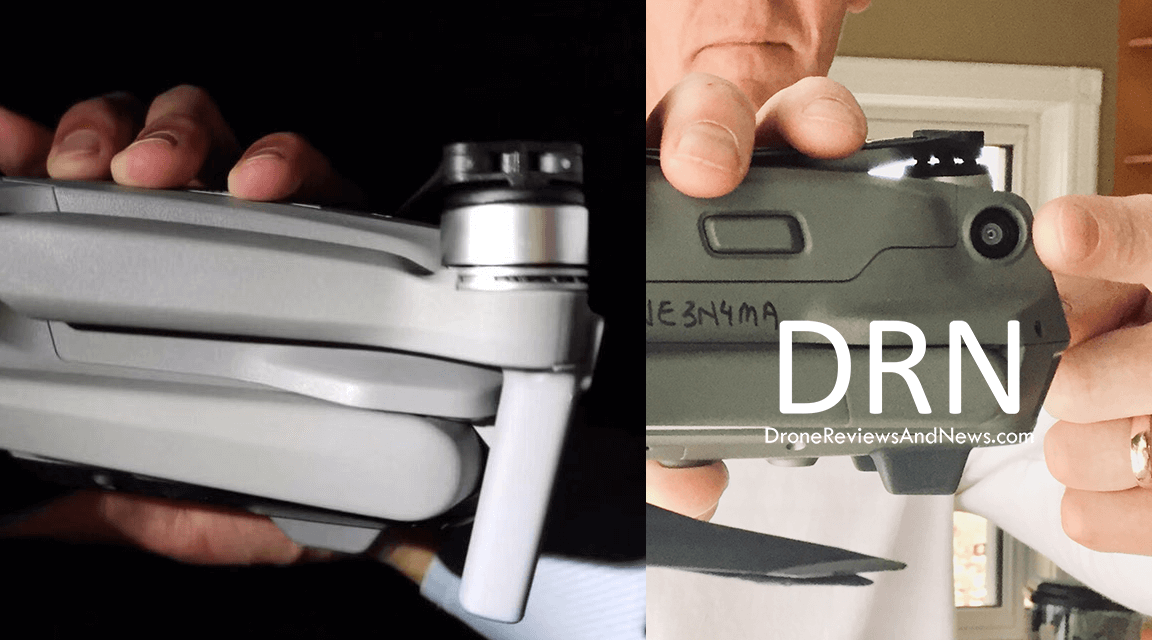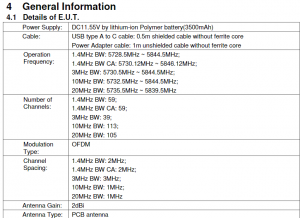With so many drone enthusiasts cooped up during the Covid-19 pandemic, even the slightest DJI rumor catches a lot of attention.
Click HERE to Bookmark the DJI Mavic Air 2 Launch Event
As usual we’ve been scouring our sources for every detail we can find on the upcoming DJI Mavic Air 2 while doing a thorough review of the leaked photos and test data.
But instead of drone rumors, today we bring you drone facts.
Battery Life
Figuring out the expected battery life is a fairly simple process when you know a drone’s weight and capacity. In this case, we have a pre-existing ‘original’ Mavic Air drone to compare to test our calculations.
The original Mavic Air Intelligent Flight Battery has a capacity of 2375 mAh against a takeoff weight of 430 grams (just under 1 pound). Knowing the battery life of the Mavic Air is 21 minutes we can plug in the battery capacity of the new Mavic Air and determine a reasonable starting point called a ‘base case’.
Our base case analysis for the Mavic Air 2 battery life puts works it out to 30.95 minutes. But the big assumption being made in this calculation is ‘that all things are equal’. What does that mean?
Well, because it’s based purely on math, it assumes that DJI has made no improvements in materials lightness/strength or ESC (electronic speed control) since the Mavic Air was released over 2 years ago.
And one cool fact we learned while analysing the FCC test reports is the Mavic Air 2 battery has 90% of the Mavic 2 Series battery capacity in a much smaller and lighter aircraft.
Knowing all about DJI’s product evolution since 2016, following release of the Mavic 2 Series and the new Mavic Mini, DJI has moved to lighter materials and made power and battery consumption improvements through enhanced ESCs, improved propeller design and ongoing battery development.
Our math above might tell us that battery life should be 31 minutes, but we expect it to be better than that…especially in a world where other competitors are starting to make a toe-hold in DJI’s market share (Autel, Powervision, Skydio, etc.).
One thing is for certain: in 2020 no one wants a drone with less than 30 minutes of flight time.
Our conclusion on the Mavic Air 2 battery life is that it will be at least 35 minutes of flight time. Possibly more.
Obstacle Avoidance
One of the biggest challenges for new drone pilots with the DJI Mavic Mini is the lack of obstacle avoidance sensors. I know many drone operators who added a Mavic Mini to their drone bag for ‘special situations’ who have crashed or lost their drone altogether.
Yes, the Mavic Mini does have bottom sensors but it’s what’s missing in the Mavic Mini that’s it’s biggest challenge.
Don’t get me wrong. The Mavic Mini is both a lot of fun to fly and it produces surprisingly decent video and stills. We still highly recommend it to our readers.
The original Mavic Air had sensors in 3 directions: front, rear and down. These are the ‘critical three’ that any drone needs for most situations. They help to protect the drone from operator error or obstacles they can’t see when the drone is flying backward.
The ‘extra’ sensors that get added to a drone (like the Mavic 2 Series) include a top sensor and side sensors. This gives a drone ‘omni-directional’ obstacle avoidance and allows a system like APAS to navigate the drone through and around a series of obstacles in real time.
From the leaked Mavic Air 2 photos we have seen so far we just don’t know with 100% certainty what the overall sensor count is. Internet ‘leakers’ have suggested that there won’t be a top sensor. We can live with that. But given the complex QuickShot modes that DJI drones can fly (like Circle, Helix, Dronie, Rocket) we think the Mavic Air 2 should have side sensors.
Back in January we took some time after CES2020 to test the Mavic Mini in Red Rock Canyon. While the drone was a lot (seriously!!) of fun to fly, there is an extra level of precautions/awareness that you need to operate a sensorless drone.
We know for certain that the Mavic Air 2 has forward, rear and downward sensors just like the original Mavic Air.
But what if using lighter materials, off-loading non-flight-related computing function to the remote control and stripping unnecessary parts (like the original Mavic Air’s folding motor mounted antenna) has made room or freed up weight for side obstacle avoidance sensors?
If the Mavic Air 2 has side sensors, they could be tucked right behind the folded front arms like the Mavic 2 Series (see below)

For this very same reason of what the motor is hiding, we think a top sensor could be located in the exact same position as on the Mavic 2 Series.
This are features we just have to categorize under ‘wait and see’. As we approach launch date, there will be many more leaked photos for us to share.
New Remote: Occusync? DJI Fly or DJI GO 4?
When we first reported on the Mavic Air 2 rumor over a month ago, the first thing that caught our eye was the new square controller. Gone are the gangly folding arms below the RC, replaced with a more intelligent location for the smart phone on top of the controller…closer to the operators field of view.
But what’s inside the new Mavic Air 2 controller?
I said above that DJI has found creative ways to offload non-flight related functions from the aircraft to the controller on previous drones. And they will certainly be relying on enhancements they developed with the Mavic 2 Smart Controller in the new Mavic Air 2.
We know from studying the FCC test reports that the new Mavic Air 2 doesn’t use the original Occusync. Original Occusync (as found in the Mavic Pro drone) operates only on the 2.4GHz frequency. Occusync 2.0 intelligently switches between 2.4GHz and 5.8GHz as needed.
And unlike the original Mavic Air, which used a Wifi radio signal, we know that the new Mavic Air 2 is not wifi. The Mavic Air only operated across 8 channels of frequency. The new Mavic Air 2 uses up to 113 channels depending on the frequency. This is almost identical to OcuSync 2.0 enabled Mavic 2 Series.
|
|
|
The image on the left, above, is the number of channels used by the Mavic Air 2 (up to 113), and the image on the right shows the 115 channels used by the Mavic 2 Series.
These almost identical, broad channel ranges across the 2.4 and 5.8 GHz spectrum are the fingerprint of OcuSync 2.0…much different than the original Mavic Air’s wifi signal which used only 8 channels.
Are you ready for it?
The new Mavic Air 2 uses OcuSync 2.0.
This will be a very welcome feature for pilots (like me) who are tired of wifi based controllers. Too much interference, especially in urban settings, has caused a lot of grief for wifi based aircraft.
We also think an all new flight control App may be coming for the Mavic Air 2 because of what you are about to read below.
Two Models of Mavic Air 2
This is the biggest feature that everyone else has missed out on. Because we read the test reports cover to cover for every DJI drone released since 2016 we can tell you that this scoop is hidden in plain sight on page 1 of the report:
[perfectpullquote align=”full” bordertop=”false” cite=”” link=”” color=”#FF0000″ class=”” size=””] “Please refer to section 2 of this report which indicates which model was actually tested and which were electrically identical. Model No.: MA2UE1N, MA2UE3W” [/perfectpullquote]
The Mavic Air 2 comes in 2 flavors: one with an ADS-B receiver and one without.

(You’ll recall that DJI announed in 2019 that all new drones produced beginning 2020 will have ADS-B receivers that detect airplanes and helicopters for enhanced safety.)
The difference between these two models may relate to which country they are being sold in based on current or pending regulations. And there will definitely be a difference in price point between the two Mavic Air 2 models.
From the FCC test report, the new Mavic Air 2 models are identical except MA2UE3W has an ADS-B RF circuit, and MA2UE1N has a magnetically permeable sheet on the upper plastic shell.
This addition of an ADS-B circuit to receive transponder signals might mean the Mavic Air 2 has it’s own flight app since the feature isn’t relevant to any of DJI’s pre-existing stable of drones.
It’s going to be really, really interesting to learn more about the Mavic Air 2 ahead of it’s release.
Camera
This almost seems to be such a less significant concern these days given how well the Mavic Mini‘s results have demonstrated.
DJI has struggled to put a 4K60fps camera in any of it’s new drones, including the Mavic 2 Series. We don’t think this has changed with the Mavic Air 2.
Both the camera and the video and still capture features will rhyme a lot with what you’ve seen from DJI over the last two years.
Still photos will still be DNG + JPEG at 12 MP.
Video will be up to 4K30fps with 100 Mbs write speed.
Because both software in post-processing and ease of enhancement has advanced so much, almost any photo or video can be made to look professional these day.
Price
This has always been the most difficult part of any new drone release. What price point will DJI park the new Mavic Air 2.
Now that we know there are two models, that complicates things even more.
Best guess was $799 when we thought there was only one model. Now that we know there are two models that means two prices.
Plus a Fly More Combo for good measure.
Mavic Air 2: $799
Mavic Air 2 ADS-B: $949
Mavic Air 2: $299
We’re pricing the FMK based on DJI’s new setup of selling it separate from the drone, rather than bundled with an aircraft.
Release Date
DJI needs to get it’s product rolling out the door. Based on previous product release cycles, DJI is very much behind other years due to Trump trade tariffs and the shutdown caused by Covid-19.
And the competitors I mentioned above have already brought new drones to market (Skydio, Powervision) or like the much anticipated Autel Evo ii are about to officially start selling any day.
Autel should be releasing the new EVOii drone any day, which could leapfrog the Mavic 2 Series in quality and function.
DJI will want to interrupt as much of that sales traffic as possible, and have targeted April 27th as the release date for the Mavic Air 2.
As always, we’ll keep you informed. Be sure to sign up for our newsletter and check out our Youtube channel.
If you have a tip, photos or other details on the Mavic Air 2 or any drone, reach out to us on our Contact page.






Pingback: DJI Mavic Air 2 drone Launch Event is now official
Pingback: Tout ce que nous savons sur le DJI Mavic Air 2 jusqu'à présent - Microdrone-France
Pingback: DJI Mavic Air 2 Sızdırıldı - Son Teknoloji
Pingback: Mavic Air 2 drone: 23 confirmed specs, and one juicy new rumor.
Pingback: TODAY NEWS: Latest World news, US News - TODAYNEWS.com
Pingback: Everything we know about the DJI Mavic Air 2 so far [Updated] | sup.news
Pingback: All the things we all know concerning the DJI Mavic Air 2 thus far [Updated] – News Buzzz
Pingback: Everything we all know about the DJI Mavic Air 2 so a ways [Updated] | Rajasthan Coverage
Pingback: Mavic Air 2: Neue Infos zu AirSense und Preis - Drone-Zone.de
Pingback: Everything we know about the DJI Mavic Air 2 so far [Updated] - DroneDJ